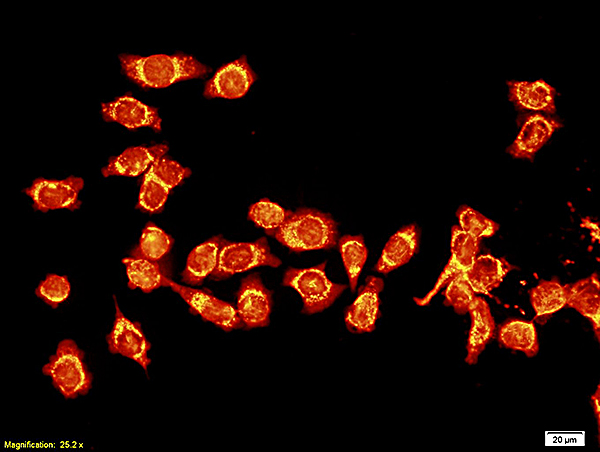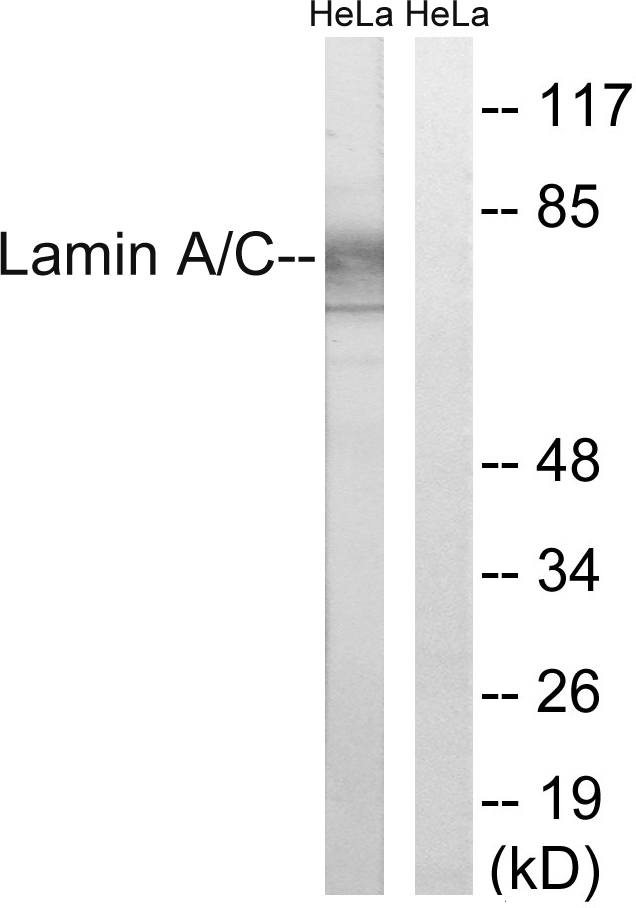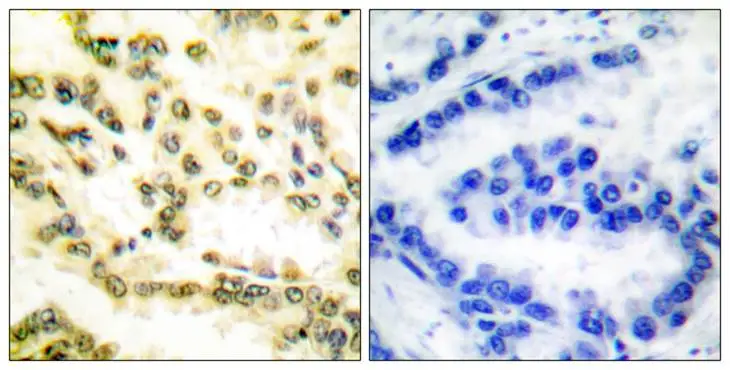![ICC/IF analysis of H9C2 cells using GTX00774 Lamin A + C antibody [GT1137]. Green: Primary antibody Blue: DAPI Dlution : 1:200 ICC/IF analysis of H9C2 cells using GTX00774 Lamin A + C antibody [GT1137]. Green: Primary antibody Blue: DAPI Dlution : 1:200](https://www.genetex.com/upload/website/prouct_img/normal/GTX00774/GTX00774_20191101_AP_002_17_w_23053121_128.webp)
ICC/IF analysis of H9C2 cells using GTX00774 Lamin A + C antibody [GT1137]. Green: Primary antibody Blue: DAPI Dlution : 1:200
Lamin A + C antibody [GT1137]
GTX00774
ApplicationsImmunoFluorescence, ImmunoPrecipitation, Western Blot, ImmunoCytoChemistry, ImmunoHistoChemistry, ImmunoHistoChemistry Paraffin
Product group Antibodies
ReactivityHuman, Mouse, Rat
TargetLMNA
Overview
- SupplierGeneTex
- Product NameLamin A + C antibody [GT1137]
- Delivery Days Customer9
- Application Supplier NoteWB: 1:50000 - 1:200000. ICC/IF: 1:50 - 1:1000. IHC-P: 1:50 - 1:1000. IP: 1:50 - 1:200. *Optimal dilutions/concentrations should be determined by the researcher.Not tested in other applications.
- ApplicationsImmunoFluorescence, ImmunoPrecipitation, Western Blot, ImmunoCytoChemistry, ImmunoHistoChemistry, ImmunoHistoChemistry Paraffin
- CertificationResearch Use Only
- ClonalityMonoclonal
- Clone IDGT1137
- ConjugateUnconjugated
- Gene ID4000
- Target nameLMNA
- Target descriptionlamin A/C
- Target synonymsCDCD1, CDDC, CMD1A, CMT2B1, EMD2, FPL, FPLD, FPLD2, HGPS, IDC, LDP1, LFP, LGMD1B, LMN1, LMNC, LMNL1, MADA, PRO1, lamin, 70 kDa lamin, epididymis secretory sperm binding protein, lamin A/C-like 1, lamin C, mandibuloacral dysplasia type A, prelamin-A/C, progerin, renal carcinoma antigen NY-REN-32
- HostRabbit
- IsotypeIgG
- Protein IDP02545
- Protein NamePrelamin-A/C
- Scientific DescriptionThe nuclear lamina consists of a two-dimensional matrix of proteins located next to the inner nuclear membrane. The lamin family of proteins make up the matrix and are highly conserved in evolution. During mitosis, the lamina matrix is reversibly disassembled as the lamin proteins are phosphorylated. Lamin proteins are thought to be involved in nuclear stability, chromatin structure and gene expression. Vertebrate lamins consist of two types, A and B. Alternative splicing results in multiple transcript variants. Mutations in this gene lead to several diseases: Emery-Dreifuss muscular dystrophy, familial partial lipodystrophy, limb girdle muscular dystrophy, dilated cardiomyopathy, Charcot-Marie-Tooth disease, and Hutchinson-Gilford progeria syndrome. [provided by RefSeq, Apr 2012]
- ReactivityHuman, Mouse, Rat
- Storage Instruction-20°C or -80°C,2°C to 8°C
- UNSPSC12352203

![ICC/IF analysis of U2OS cells using GTX00774 Lamin A + C antibody [GT1137]. Green: Primary antibody Blue: DAPI Dlution : 1:200 ICC/IF analysis of U2OS cells using GTX00774 Lamin A + C antibody [GT1137]. Green: Primary antibody Blue: DAPI Dlution : 1:200](https://www.genetex.com/upload/website/prouct_img/normal/GTX00774/GTX00774_20191101_AP_002_18_w_23053121_131.webp)
![ICC/IF analysis of L929 cells using GTX00774 Lamin A + C antibody [GT1137]. Green: Primary antibody Blue: DAPI The image was taken by Confocal microscopy. Dlution : 1:200 ICC/IF analysis of L929 cells using GTX00774 Lamin A + C antibody [GT1137]. Green: Primary antibody Blue: DAPI The image was taken by Confocal microscopy. Dlution : 1:200](https://www.genetex.com/upload/website/prouct_img/normal/GTX00774/GTX00774_20191101_AP_002_19_w_23053121_348.webp)
![ICC/IF analysis of HeLa cells using GTX00774 Lamin A + C antibody [GT1137]. Red: Primary antibody Blue: DAPI Detection system: confocol Dlution : 1:100 ICC/IF analysis of HeLa cells using GTX00774 Lamin A + C antibody [GT1137]. Red: Primary antibody Blue: DAPI Detection system: confocol Dlution : 1:100](https://www.genetex.com/upload/website/prouct_img/normal/GTX00774/GTX00774_20191101_AP_002_20_w_23053121_867.webp)
![ICC/IF analysis of U2OS cells using GTX00774 Lamin A + C antibody [GT1137]. Pink: Primary antibody Blue: DAPI Dlution : 1:100-1:1600 ICC/IF analysis of U2OS cells using GTX00774 Lamin A + C antibody [GT1137]. Pink: Primary antibody Blue: DAPI Dlution : 1:100-1:1600](https://www.genetex.com/upload/website/prouct_img/normal/GTX00774/GTX00774_20191101_AP_002_21_w_23053121_755.webp)
![IHC-P analysis of hmuan breast cancer tissue section using GTX00774 Lamin A + C antibody [GT1137]. Dlution : 1:200 IHC-P analysis of hmuan breast cancer tissue section using GTX00774 Lamin A + C antibody [GT1137]. Dlution : 1:200](https://www.genetex.com/upload/website/prouct_img/normal/GTX00774/GTX00774_20191101_AP_003_15_w_23053121_217.webp)
![IHC-P analysis of hmuan esophageal cancer tissue section using GTX00774 Lamin A + C antibody [GT1137]. Dlution : 1:400 - 1:3200 IHC-P analysis of hmuan esophageal cancer tissue section using GTX00774 Lamin A + C antibody [GT1137]. Dlution : 1:400 - 1:3200](https://www.genetex.com/upload/website/prouct_img/normal/GTX00774/GTX00774_20191101_AP_003_16_w_23053121_287.webp)
![IP analysis of K562 whole cell lysate using GTX00774 Lamin A + C antibody [GT1137]. Total protein amount : 200microg IP antibody : 3microg Dilution : 1:20000 IP analysis of K562 whole cell lysate using GTX00774 Lamin A + C antibody [GT1137]. Total protein amount : 200microg IP antibody : 3microg Dilution : 1:20000](https://www.genetex.com/upload/website/prouct_img/normal/GTX00774/GTX00774_20200327_IP_7_w_23053121_725.webp)
![WB analysis of HeLa whole cell lysate using GTX00774 Lamin A + C antibody [GT1137]. Dilution :1:10000-1:2560000 Loading : 25microg WB analysis of HeLa whole cell lysate using GTX00774 Lamin A + C antibody [GT1137]. Dilution :1:10000-1:2560000 Loading : 25microg](https://www.genetex.com/upload/website/prouct_img/normal/GTX00774/GTX00774_20200327_WB_1_w_23053121_865.webp)
![WB analysis of various samples using GTX00774 Lamin A + C antibody [GT1137]. Dilution : 1:50000 Loading : 25microg WB analysis of various samples using GTX00774 Lamin A + C antibody [GT1137]. Dilution : 1:50000 Loading : 25microg](https://www.genetex.com/upload/website/prouct_img/normal/GTX00774/GTX00774_20200327_WB_2_w_23053121_343.webp)




![WB analysis of 10microg nuclear extract from fractionated mouse tissue lysate using GTX80813 Lamin A + C antibody [mab636]. Dilution : 1:500](https://www.genetex.com/upload/website/prouct_img/normal/GTX80813/GTX80813_1958_WB_w_23061322_879.webp)
